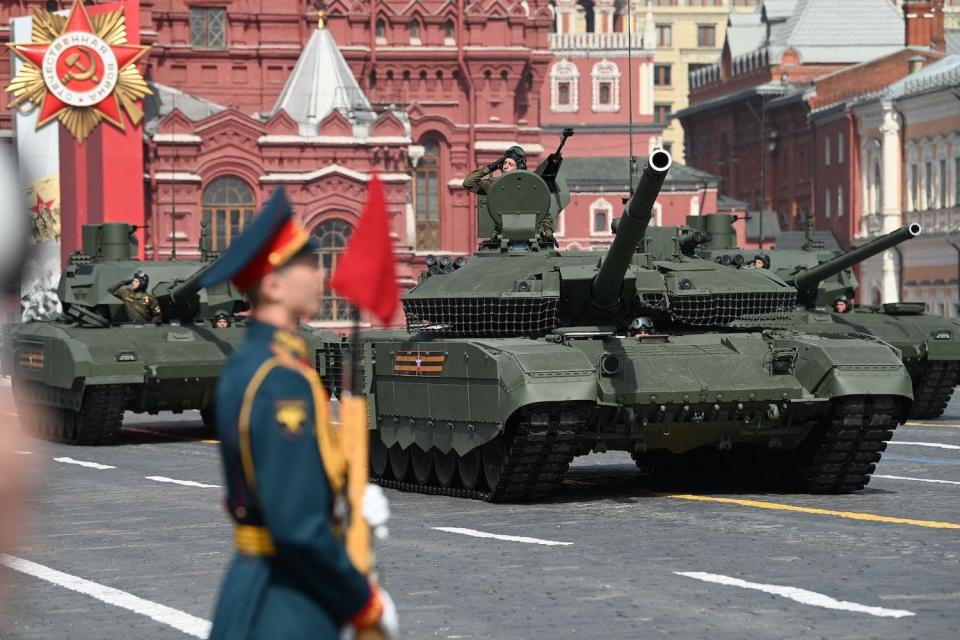Russia's new tank — its T-14 Armata — is probably too expensive to use in Ukraine, top weapons maker says

Russia's most advanced tank is likely too costly to use in Ukraine, the head of a top defense firm said.
The new T-14 Armata is estimated to cost between $5 million and $9 million.
Russia previously said it deployed the tank in combat, but Ukraine pushed back on this.
Moscow is unlikely to be using its new tank, the T-14 Armata, on the battlefield in Ukraine because the system is far too costly, the head of a Russian state-owned weapons manufacturer said on Monday.
The new T-14 is much more advanced and functional than Russia's arsenal of existing tanks, but it is "too expensive" to be fielded in Ukraine, Sergey Chemezov, director general of the defense conglomerate Rostec, told the RIA state news agency.
The Armata is estimated to cost between $5 million and $9 million, considerably more expensive than Russia's T-90, T-80, and T-72 tanks — all of which Moscow has deployed in Ukraine. All of these tanks have suffered heavy losses there as well.
Chemezov clarified that the new main battle tank is in service with the Russian army.

When the Armata was unveiled in 2015, it drew concern from some Western analysts who worried that the next-generation tank could rival NATO systems like the M1 Abrams, Challenger 2, or Leopard 2, which Ukraine has employed against Russia.
Russia has touted the T-14 as "cutting-edge" weaponry The three-man crew can remotely operate its 125 mm cannon from the safety of the hull, which is protected by thick armor. The Armata also contains sophisticated sensors, onboard drones, technology that can defend it against enemy anti-tank rockets, and various automated functions.
But years into its development, the T-14 program has run into problems, including delays, manufacturing problems, and reduction of the overall fleet size. There have also been question about the tank's reliability.
Britain's defense ministry said in early 2023 that Russia was considering the deployment of its Armatas to Ukraine, but called it a "high-risk decision" given its issues. The UK said the tanks would strain Russia's logistics chain because they are heavier and larger than other armor, and it noted that commanders would be "unlikely to trust" the system in combat.

Russian state media previously claimed that its T-14s had already deployed to Ukraine, with examples ranging from short front-line stints to shooting at Kyiv's forces from a distance without participating in direct assault operations — the latter resembling Moscow's experience with its Su-57 fifth-generation fighter jet. Ukrainian intelligence, however, has pushed back on these claims and said it hasn't seen any T-14s in action.
Chemezov told RIA that it's easier for the Russian military to buy older T-90s — a third-generation main battle tank — than it is to field the T-14s in Ukraine.
Russian President Vladimir Putin previously bragged that the T-90 was the "world's best tank," although Ukraine has managed to destroy these systems with small drones and armored vehicles. In one particular incident that went viral earlier this year, a US-made Bradley was captured on video obliterating a T-90M with chain gun fire.
Russia's arsenal of heavy armor — including its tank force — has taken a serious beating in Ukraine since the start of the full-scale invasion more than two years ago.

Moscow likely initially deployed around 1,300 tanks and more than 5,000 infantry fighting vehicles and armored personnel carriers in Ukraine, and its losses now stand at 2,700 tanks and 5,000 IFVs and APCs, Britain's defense ministry shared in a Sunday intelligence update.
Beyond these armor losses, more than 355,000 Russian soldiers have been killed or wounded since the war started, per Britain's figures. Last month saw Moscow suffer its highest casualty rate of any month during the bloody campaign, averaging 983 losses a day.
"The increase in the daily average almost certainly reflects Russia's commitment to mass and attritional warfare," Britain said. '"Although costly in terms of human life, the resulting effect has increased the pressure on Ukraine's positions across the front line."
Read the original article on Business Insider


